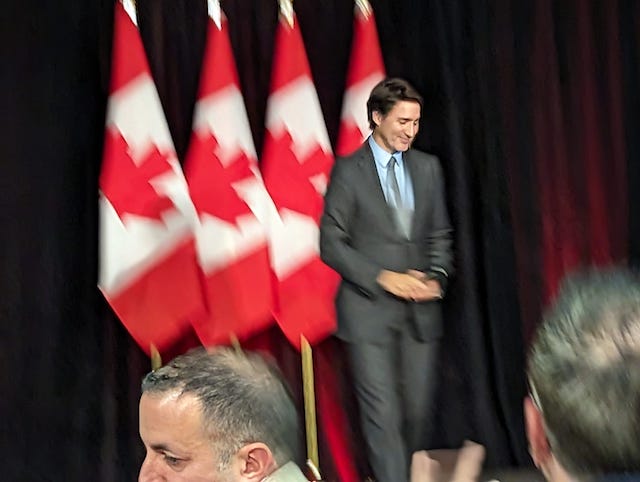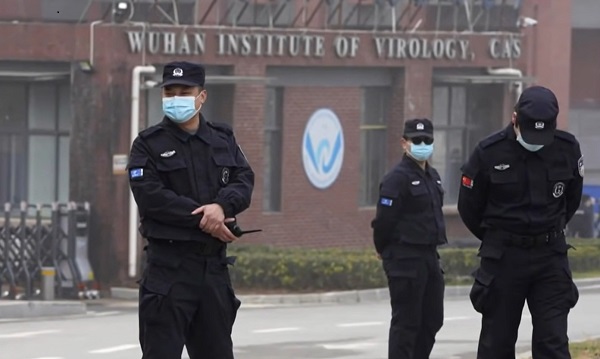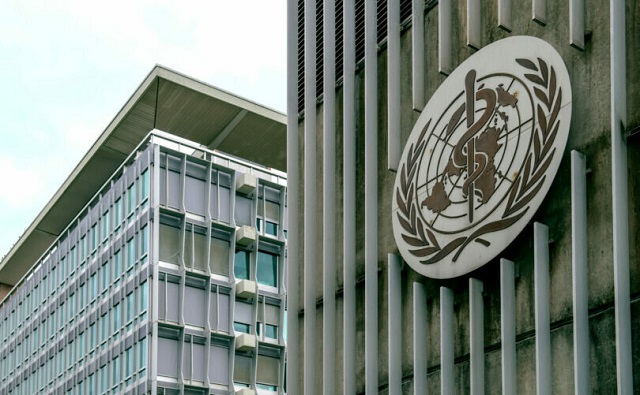Opinion
Tuesday-night Trudeau

Justin Trudeau at Gatineau Airport, Oct 24 – Photo by PW
Posted with permission from Paul Wells
Justin Trudeau in a hangar, before the comeback, if there’s going to be one
If Justin Trudeau’s historic comeback happens, it will start sometime after Tuesday night, when he spoke to a Liberal Party of Canada fundraiser at the one-runway Gatineau Airport, 21 minutes’ drive from Rideau Cottage on the Quebec side of the river.
The prime minister is two months short of his 52nd birthday. Brian Mulroney was not quite 54 when he became the youngest undefeated prime minister, so far, to announce his retirement from politics. This is the sort of week when I look up numbers like that.
The polls since summer haven’t been kind to the Liberals. I have readers who get cross with me when I mention polls, but I cover the most polling-obsessed government in Canada’s history, and I must decline requests to unilaterally disarm.
Trudeau and his ministers do fundraisers all the time, as do the leaders and prominent MPs in other parties. The only difference on Tuesday was that I went to watch. After some embarrassing early headlines about fundraisers soon after the 2015 election, the Liberal Party changed its rules to increase transparency in fundraising. Now reporters get advance notice whenever Trudeau will be speaking at a fundraiser. I wanted to see what Trudeau says at such things these days, precisely because they’re routine events. Hearing how the prime minister talks to friendlies on a Tuesday night near home was, perhaps, the closest I could get to hearing how he talks to himself.
This event was a fundraiser for Gatineau MP Steven MacKinnon, a former Liberal Party national director who is serving as the government’s house leader while Karina Gould is on maternity leave. Two cabinet ministers were on hand too, Jean-Yves Duclos and Anita Anand. An organizer told the audience he’d been asked to get a smallish crowd out, “a good 50 or so;” since 67 people bought tickets, he was pretty pleased. The party had announced a ticket price up to $1,500. The crowd was of the sort that routinely gets described as overwhelmingly white and male when it’s a Conservative event, which means it was overwhelmingly white and male, but Liberal.
Trudeau spoke for twelve minutes. He opened by saying nice things about MacKinnon and thanked the two cabinet ministers. Poor Duclos thought he was just out to socialize, Trudeau joked, but Duclos is the minister of public services and procurement, “and around here we talk about a bridge.” Gales of laughter from the crowd. The riding association guy had also mentioned a bridge. There has been endless talk about a sixth bridge between Ottawa and Gatineau; neighbours near the various possible routes are leery, but a lot of people hope a new bridge would improve traffic flow, which often includes bumper-to-bumper heavy trucks on ordinary streets through the middle of Ottawa. A lot of the people who want the bridge the most run businesses. Judging from the PM’s choice of comic patter, they won’t have to wait long.
Trudeau thanked the crowd for coming out. “I know very well that everyone has plenty of choices for the various activities they could undertake on a Tuesday night in the month of October,” he said. This may have flattered the selection of fun activities in Gatineau on a Tuesday.
“You chose to come participate in a democratic event,” Trudeau continued. This was an instinct he could only applaud: “We know very well these days that it’s not always very motivating to get involved in politics. To raise your hand and say, ‘No, no, no, I want to participate in our democracy in an active and involved way. To take part in the conversations we’re having as a country in these difficult moments.’”
Trudeau contrasted this positive spirit with what certain other people, so far unnamed, like to do. “It’s very easy to point our finger at politicians, to complain about inflation or the pandemic or interest rates or labour shortages or housing or all these issues. It’s very easy, and many people decide to turn toward anger, anxiety, fear or division. Because it really pays over the short term, in politics, to rely on fear and division. But it’s so much more important to have a responsible, sensible approach, anchored in shared values. To try to bring us together rather than to divide us in an attempt to win a few points in the polls.”
One sensed an emerging central theme of contrast. “Your choice to come tonight to this Liberal event is enormously touching to me,” Trudeau said. “Because for eight years now, we’ve tried to be a government that stayed rooted in real things. In facts. In shared values. We bring people together rather than divide them for strategic reasons.”
Not only does his government, in his telling, think like good people, it does things good people will like.
“We manage to deliver for people. Even in extremely difficult moments like the ones we’re living through. People are struggling, because of the global context, extremely complex geopolitics that have a direct impact on pocketbooks, on groceries and rent. We have an important role to play as a government, to respond to today’s needs. That’s why we’ve made investments to help people pay their bills, to increase competition among the big grocers. We’re there to provide more daycare spaces. We’re there to help with dental care. We’re there to help with the Canada Child Benefit, which has lifted half a million children out of poverty in recent years. We’re there to create economic growth even as we fight against climate change.”
His audience for the night being mostly Quebecers and, as far as I could tell, mostly in business, the Liberal leader refined his course of general flattery to one of specific business-oriented flattery.
“I’m very proud of what we’ve been able to deliver in Quebec: Northvolt, Rio Tinto, REM… These are investments that show how much — here in Quebec where we’ve always understood that environmental protection and economic growth go together — everyone can make progress together.”
This was a pretty upbeat message, as partisan messages often are — we have the right ideas and the right results, and the other team is trying to wreck it all — but here again, as when he lamented how “not very motivating” the political life can be, Trudeau introduced a distinctly mournful note.
“As usual, it’s a bigger challenge to get this message out in the rest of Canada,” he said. At the risk of talking about polls, I couldn’t help thinking Trudeau was referring to recent pee oh ell ells that show Quebec as the only part of the country where his Liberals are in the lead. Despite big federal spending on Volkswagen ($13 billion) and Stellantis (probably more), the clean green future seems not to tempt a lot of Canadians. “It still feels far off, because the day-to-day is still difficult for many Canadians,” he said. “But we know very well that a society and a future are built step by step.…When we stay optimistic, when we’re reasonable, everything becomes possible in the future.”
This, he said, summing up, was “the political debate we’re having now…. Within two years — probably in two years — we’ll have elections.” That’s when people will get a chance to choose directions.
“Will we go back to the Conservative ways of trickle-down, cuts to social programs, advantages for the well-off in the hopes that they’ll eventually give everyone opportunity? It’s never worked and it won’t work better now.” Or would voters stick with the government Trudeau sees in the mirror? “We’re going to stay responsible but we’re going to keep investing,” he said.
Only now, at the end of his remarks, did Trudeau switch from French to English. “It’s always an incredible pleasure to spend time with people who are dedicated every day to building stronger communities and a stronger country.” And that was the end of that. The applause lasted for sixteen seconds. PMO staff led reporters out of the room — our access ends when the big guy stops talking.

A few observations on all this.
First, I’m struck by the way Trudeau narrowed down his expectation of election timing: “Within two years — probably in two years.” Probably anyone in a position of responsibility in any party would say an election could come any time, it’s wise to be ready, and so on. But in Trudeau’s mind, the supply and confidence agreement with the NDP seems likely to hold. He is not in a rush. Judgment Day isn’t until 2025.
Second, if he’s getting any advice to hit pause on carbon taxes, he sure doesn’t sound like he’s getting ready to take the advice. The heart of his case for himself is the notion that you can have clean energy and a thriving economy, and indeed that the latter depends on the former. That argument doesn’t require a carbon tax — theoretically, if you subsidize enough battery plants gasoline will become obsolete — but nothing in Trudeau’s fundraiser stump speech sounded like he was laying the predicate for a major retreat on carbon taxes.
BIG HONKING UPDATE, MINUTES LATER:
The feds have made a large announcement that shows the risks in making predictions. I quote:
“The Prime Minister, Justin Trudeau, today announced the government is moving ahead with doubling the pollution price rebate (Climate Action Incentive Payment) rural top-up rate, increasing it from 10 to 20 per cent of the baseline amount starting in April 2024. People who live in rural communities face unique realities, and this measure would help put even more money back in the pockets of families dealing with higher energy costs because they live outside a large city.
“Given the pressures faced by households and small businesses that use oil heating, the Prime Minister also announced that the government is moving ahead with a temporary, three-year pause to the federal price on pollution (fuel charge) on deliveries of heating oil in all jurisdictions where the federal fuel charge is in effect. This pause would begin 14 days from today. While the fuel charge is already returned to consumers through the pollution price rebate, this temporary pause would save a household that uses heating oil $250 at the current rate, on average, while the federal government works with provinces to roll out heat pumps and phase out oil for heating over the longer term.”
Third, and more generally, the case Trudeau was building was for more of the same. “It still feels far off, because the day-to-day is still difficult for many Canadians,” he said, which is how you talk when you’re hoping your ship comes in before people get a chance to pass judgment.
Incidentally, here I think it’s only fair to point out there’s been recent progress on files I often point to as evidence that Liberal plans never pan out. The Canada Growth Fund, the object of this newsletter’s first post, made its first investment this week, a $90 million equity play in a Calgary geothermal energy company. The Canada-US Energy Transformation Task Force held a second meeting. Maybe two years of process news like that will add up to an electorate that’s excited about Canada’s energy transformation. I mean, it’s possible.
Most of all, I was struck by how “more of the same” had better work for the Liberals, because if the boss has a better idea, he’s hiding it well. A leader who once ran on cost-of-living issues…
… is now running on the clean-energy future that feels tantalizingly out of reach, and lamenting his opponent’s insistence on running on cost-of-living issues. His best hunch about timing is that he has no reason to rush, and his best assessment of his work to date is that he needs to do more of it.
Liberals who feel more of a sense of urgency, futility or wasted energy will just have to get on board, I guess. The leader’s not for turning.
Subscribe to Paul Wells
Politics and culture as though they mattered.
Daily Caller
Daily Caller EXCLUSIVE: Trump’s Broad Ban On Risky Gain-Of-Function Research Nears Completion


From the Daily Caller News Foundation
By Emily Kopp
President Donald Trump could sign a sweeping executive order banning gain-of-function research — research that makes viruses more dangerous in the lab — as soon as May 6, according to a source who has worked with the National Security Council on the issue.
The executive order will take a broad strokes approach, banning research amplifying the infectivity or pathogenicity of any virulent and replicable pathogen, according to the source, who requested anonymity to speak candidly about the anticipated executive action. But significant unresolved issues remain, according to the source, including whether violators will be subject to criminal penalties as bioweaponeers.
The executive order is being steered by Gerald Parker, head of the White House Office of Pandemic Preparedness and Response Policy, which has been incorporated into the NSC. Parker did not respond to requests for comment.
Dear Readers:
As a nonprofit, we are dependent on the generosity of our readers.
Please consider making a small donation of any amount here. Thank you!
In the process of drafting the executive order, Parker has frozen out the federal agencies that have for years championed gain-of-function research and staved off regulation — chiefly Anthony Fauci’s former institute, the National Institute of Allergy and Infectious Diseases at the National Institutes of Health.
The latest policy guidance on gain-of-function research, unveiled under the Biden administration in 2024, was previously expected to go into effect May 6. According to a March 25 letter cosigned by the American Society for Microbiology, the Association for Biosafety and Biosecurity International, and Council on Governmental Relations, organizations that conduct pathogen research have not received direction from the NIH on that guidance — suggesting the executive order would supersede the May 6 deadline.
The 2024 guidance altered the scope of experiments subject to more rigorous review, but charged researchers, universities and funding agencies like NIH with its implementation, which critics say disincentivizes reporting. Many scientists say that researchers and NIH should not be the primary entities conducting cost–benefit analyses of pandemic virus studies.
Parker previously served as the head of the National Science Advisory Board for Biosecurity (NSABB), a group of outside experts that advises NIH on biosecurity matters, and in that role recommended that Congress stand up a new government agency to advise on gain-of-function research. Former Centers for Disease Control and Prevention Director Robert Redfield has also endorsed moving gain-of-function research decision making out of the NIH to an independent commission.
“Given the well documented lapses in the NIH review process, policymakers should … remove final approval of any gain-of function research grants from NIH,” Redfield said in a February op-ed.
It remains to be seen whether the executive order will articulate carveouts for gain-of-function research without risks of harm such as research on non-replicative pseudoviruses, which can be used to study viral evolution without generating pandemic viruses.
It also remains to be seen whether the executive order will define “gain-of-function research” tightly enough to stand up to legal scrutiny should a violator be charged with a crime.
Risky research on coronaviruses funded by the NIH at the Wuhan Institute of Virology through the U.S. nonprofit EcoHealth Alliance typifies the loopholes in NIH’s existing regulatory framework, some biosecurity experts say.
Documents obtained through the Freedom of Information Act in 2023 indicated that EcoHealth Alliance President Peter Daszak submitted a proposal to the Pentagon in 2018 called “DEFUSE” describing gain-of-function experiments on viruses similar to SARS-CoV-2 but downplayed to his intended funder the fact that many of the tests would occur in Wuhan, China.
Daszak and EcoHealth were both debarred from federal funding in January 2025 but have faced no criminal charges.
“I don’t know that criminal penalties are necessary. But we do need more sticks in biosafety as well as carrots,” said a biosecurity expert who requested anonymity to avoid retribution from his employer for weighing in on the expected policy. “For instance, biosafety should be a part of tenure review and whether you get funding for future work.”
Some experts say that it is likely that the COVID-19 crisis was a lab-generated pandemic, and that without major policy changes it might not be the last one.
“Gain-of-function research on potential pandemic pathogens caused the COVID-19 pandemic, killing 20 million and costing $25 trillion,” said Richard Ebright, a Rutgers University microbiologist and longtime critic of high-risk virology, to the Daily Caller News Foundation. “If not stopped, gain-of-function research on potential pandemic pathogens likely will cause future lab-generated pandemics.”
John Stossel
Climate Change Myths Part 1: Polar Bears, Arctic Ice, and Food Shortages

From StosselTV
Climate zealots tell us the end is near. It’s the era of “global BOILING!” says the UN Secretary General. Climate alarmists say the Arctic will soon be ice-free and cities will be underwater! But what do the facts say?
The facts say that the climate change fanatics’ catastrophic claims are wrong.
In this video and the next, we’ll debunk 7 myths about climate change.
First up: melting ice, polar bear extinction, and climate change famines.
Here are the sources for this video:
No new record low summer ice extent observed since 2012. https://agupubs.onlinelibrary.wiley.c…
Satellite data show average annual sea ice volume largely stable since 2010: https://psc.apl.uw.edu/wordpress/wp-c…
Total arctic ice mass: http://psc.apl.uw.edu/research/projec…
Polar Bear Estimates 1993-today: https://www.iucn-pbsg.org/wp-content/…
1981: https://portals.iucn.org/library/site…
1960s: https://www.google.com/books/edition/…
Global agricultural output: https://ourworldindata.org/grapher/ag…
NASA Greening study: https://www.nasa.gov/centers-and-faci…
Malnutrition deaths: https://ourworldindata.org/grapher/ma…
Coffee production: https://www.fao.org/faostat/en/#compare
After 40+ years of reporting, I now understand the importance of limited government and personal freedom. ”
——————————————
Libertarian journalist John Stossel created Stossel TV to explain liberty and free markets to young people.
Prior to Stossel TV he hosted a show on Fox Business and co-anchored ABC’s primetime newsmagazine show, 20/20.
Stossel’s economic programs have been adapted into teaching kits by a non-profit organization, “Stossel in the Classroom.” High school teachers in American public schools now use the videos to help educate their students on economics and economic freedom. They are seen by more than 12 million students every year.
Stossel has received 19 Emmy Awards and has been honored five times for excellence in consumer reporting by the National Press Club. Other honors include the George Polk Award for Outstanding Local Reporting and the George Foster Peabody Award.
_ _ _ _ _ _
In order not to miss the next video from Stossel TV, sign up here: https://johnstossel.activehosted.com/f/1
_ _ _ _ _ _
-

 2025 Federal Election2 days ago
2025 Federal Election2 days agoRCMP Whistleblowers Accuse Members of Mark Carney’s Inner Circle of Security Breaches and Surveillance
-

 Also Interesting2 days ago
Also Interesting2 days agoBetFury Review: Is It the Best Crypto Casino?
-

 Autism2 days ago
Autism2 days agoRFK Jr. Exposes a Chilling New Autism Reality
-

 COVID-192 days ago
COVID-192 days agoCanadian student denied religious exemption for COVID jab takes tech school to court
-

 2025 Federal Election2 days ago
2025 Federal Election2 days agoBureau Exclusive: Chinese Election Interference Network Tied to Senate Breach Investigation
-

 International2 days ago
International2 days agoUK Supreme Court rules ‘woman’ means biological female
-

 2025 Federal Election2 days ago
2025 Federal Election2 days agoNeil Young + Carney / Freedom Bros
-

 Health2 days ago
Health2 days agoWHO member states agree on draft of ‘pandemic treaty’ that could be adopted in May





